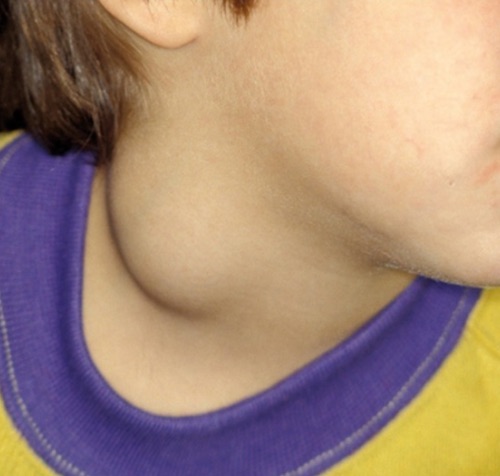Pediatric Surgery: Branchial Cleft Anomalies
Branchial Cleft Anomalies
Basics
- From Incomplete Branchial Cleft Obliteration During Embryogenesis
- 10% are Bilateral
- Risk for Recurrent Infection & Later Malignancy
- 20% Become Infected Prior to Excision
Presentation
- Classic Presentation: Lateral Mass Along the SCM
- Presentations:
- Cartilaginous Remnant
- Cyst – No External Opening
- Draining Sinus – Opening to Either External Skin or Internal Pharynx
- More Common than in Thyroglossal Duct Cysts
- Fistula – Communication Between Both External Skin & Internal Pharynx
First Branchial Cyst
- Location: From Angle of Mandible to External Acoustic Meatus
- Often Closely Associated with Facial Nerve & Parotid Gland
- At Risk During Excision
- May Have Connection to External Acoustic Meatus (Otorrhea/Infection)
- Subtypes:
- I: Lateral to Facial Nerve
- II: Medial to Facial Nerve
Second Branchial Cyst
- Most Common Type
- Location: From Supraclavicular Fossa to Tonsillar Pillar
- Tract Travels Through the Carotid Bifurcation
- Subtypes:
- I: Anterior Border of SCM
- Most Superficial – Lowest Risk of Nerve Injury
- II: Adjacent to Internal Carotid Artery & Adherent to Internal Jugular Vein
- Most Common Subtype
- III: Between Internal & External Carotid Arteries within the Carotid Bifurcation
- IV: Deep to Carotid Sheath; Adjacent to Pharynx
- I: Anterior Border of SCM
Piriform Sinus Tract
- Generic Term for Both Third/Fourth Tracts
- May Be Difficult to Distinguish
- Third Enters Above the Superior Laryngeal Nerve
- Fourth Enters Below the Superior Laryngeal Nerve
- Location:
- Third: Posterior Cervical Space by Lower SCM
- Fourth: Descend into Mediastinum Along Tracheoesophageal Groove
- Left Sided Most Common
Treatment
- Definitive Tx: Excision of Entire Tract
- Transverse Cervical Incision Along a Skin Crease
- Elliptical Incision Over Draining Sinus
- Piriform Sinus Tracts Often Require Ipsilateral Thyroid Lobectomy
- Transverse Cervical Incision Along a Skin Crease
- Infected: Antibiotics & Delayed Excision
- Antibiotics Should Cover Skin Flora (Add Broad Spectrum if an Oropharynx Connection is Suspected)
- May Require Aspiration or Incision & Drainage if Abscess Develops
Associated Syndromes
- Branchio-Oto-Renal (BOR) Syndrome
- Autosomal Dominant Condition
- Presentation:
- Branchial Cleft Cysts (May See “Preauricular Pits/Tags”)
- Ear Abnormalities (Hearing Loss & Malformation)
- Renal Abnormalities
- Branchio-Otic Syndrome (BOS)
- Similar to BOR Syndrome but No Renal Abnormalities
- Branchio-Oculo-Facial Syndrome
- Autosomal Dominant Condition
- Presentation:
- Branchial Cleft Cysts (May See “Preauricular Pits/Tags”)
- Eye Abnormalities (Microphthalmia & Obstructed Lacrimal Ducts)
- Facial Abnormalities (Cleft Lip/Palate)

Branchial Cleft Cyst 1

Branchial Cleft Cyst – Fistulogram 2

Preauricular Pit and Tag 3
References
- Lang S, Kansy B. Cervical lymph node diseases in children. GMS Curr Top Otorhinolaryngol Head Neck Surg. 2014 Dec 1;13:Doc08. (License: CC BY-NC-ND-3.0)
- JoJo. Wikimedia Commons. (License: CC BY-3.0)
- Spahiu L, Merovci B, Ismaili Jaha V, Batalli Këpuska A, Jashari H. Case report of a novel mutation of theEYA1 gene in a patient with branchio-oto-renal syndrome. Balkan J Med Genet. 2017 Mar 4;19(2):91-94. (License: CC BY-NC-ND-4.0)